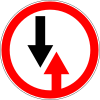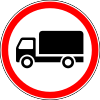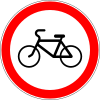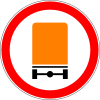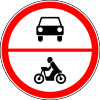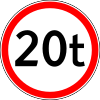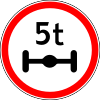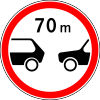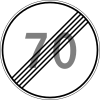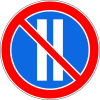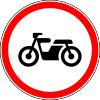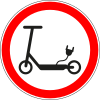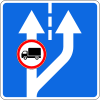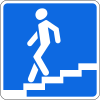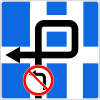
Road signs in Norway are regulated by the Norwegian Public Roads Administration, Statens vegvesen in conformity with the 1968 Vienna Convention on Road Signs and Signals, to which Norway is a signatory.

Road signs in Italy conform to the general pattern of those used in most other European countries, with the notable exception that the background of motorway (autostrada) signs is green and those for 'normal' roads is blue. They are regulated by the Codice della Strada and by the Regolamento di Attuazione del Codice della Strada in conformity with the 1968 Vienna Convention on Road Signs and Signals.

Road signs in South Korea are regulated by the Korean Road Traffic Authority.

Road signs in Finland were formerly regulated in Tieliikenneasetus (5.3.1982/182), but now are currently regulated in Siirtymäsäännökset (8.5.2020/360).

Road signs in Austria are regulated in Straßenverkehrsordnung (StVO).
Road signs in Ukraine are governed by a combination of standards set out by the Vienna Convention on Road Signs and Signals, the European Union (EU), and Ukraine Transport and Roads Agency. Ukrainian signs are similar to the signs of other post-Soviet states and are set out in 7 separate categories based on meaning: warning, priority, prohibitory, mandatory, information, service, and additional plates.
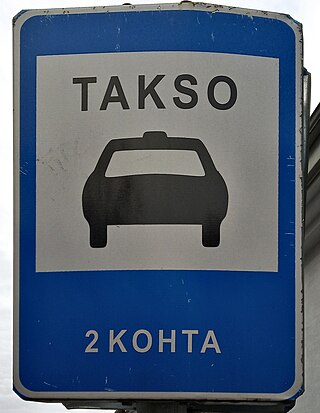
Road signs in Estonia ensure that transport vehicles move safely and orderly, as well as to inform the participants of traffic built-in graphic icons. These icons are governed by the Vienna Convention on Road Traffic and Vienna Convention on Road Signs and Signals. The system is covered in Liiklusmärkide ja teemärgiste tähendused ning nõuded fooridele and the standards document EVS 613:2001 Traffic signs.
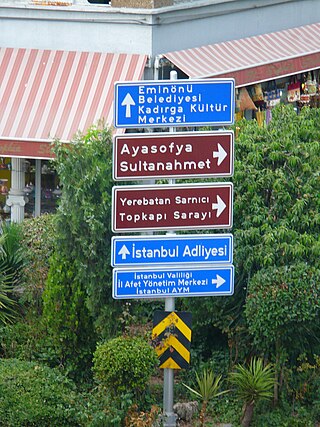
Road signs in Turkey conform to the general pattern of those used in most other European countries and set out in the Vienna Convention on Road Signs and Signals. They are regulated by the Trafik İşaretleri Elkitabi.

Road signs in Azerbaijan are similar to the road sign system of post-Soviet states that ensure that transport vehicles move safely and orderly, as well as to inform the participants of traffic built-in graphic icons. They generally conform to the Vienna Convention on Road Traffic and Vienna Convention on Road Signs and Signals.

Road signs in Mongolia are similar to the Soviet, British, and other European road sign systems. Road signs are regulated in the MNS 4597:2014 standard and conform to the general pattern of road signs as set out in the Vienna Convention on Road Signs and Signals. Despite the fact that Mongolia was never part of the Soviet Union, the MNS 4597:2014 standard for road signs has many similarities with its post-Soviet counterparts based on the Soviet standard ГОСТ 10807-78 and the Russian standard ГОСТ Р 52290-2004. Mongolia acceded to the Vienna Convention on Road Signs and Signals on December 19, 1997.

Road signs in Georgia are similar to the road sign system of other post-Soviet states that ensure that transport vehicles move safely and orderly, as well as to inform the participants of traffic built-in graphic icons. However, some road signs look a bit different from Soviet ones and closer to the European ones. These icons are governed by the Vienna Convention on Road Traffic and Vienna Convention on Road Signs and Signals.

Road signs in Kazakhstan are similar to the road sign system of other post-Soviet states that ensure that transport vehicles move safely and orderly, as well as to inform the participants of traffic built-in graphic icons. These icons are governed by the Vienna Convention on Road Traffic and Vienna Convention on Road Signs and Signals. Road signs are regulated by the СТ РК 1125-2021 standard.

Road signs in Kyrgyzstan are similar to the road sign system of other post-Soviet states that ensure that transport vehicles move safely and orderly, as well as to inform the participants of traffic built-in graphic icons. These icons are governed by the Vienna Convention on Road Traffic and Vienna Convention on Road Signs and Signals.

Road signs in Uzbekistan are regulated by the O'zDst 3283-2017 standard. Due to the country being a former Soviet Socialist Republic between 1924 and 1991, road signs are similar in design to those used in the Soviet Union before its dissolution in 1991, as well as in most other post-Soviet states. Uzbekistan acceded to the Vienna Convention on Road Signs and Signals on January 17, 1995. The Soviet Union itself was once a signatory to the Vienna Convention on Road Signs and Signals.

The road signs, used on the Serbian road network, are regulated by the "Regulation of Traffic Signs", which was last time modified in 2017.

Road signs in Russia are governed by the traffic rules approved by the Decree of the Government of the Russian Federation No. 1090 of 23 October 1993 “On the Rules of the Road”, Appendix 1 “Road Signs”. They are regulated by the ГОСТ Р 52289-2019 and ГОСТ Р 52290-2004 standards determining the rules for the use and production of road signs. The vast majority of road signs used in Russia were in the preceding Soviet standard ГОСТ 10807-78, which was introduced in the Soviet Union on 1 January 1980 before its dissolution in 1991 and is no longer valid in Russia since 1 January 2006 after it was replaced by the modern standard ГОСТ Р 52290-2004 for road signs. Road signs generally conform to the Vienna Convention on Road Signs and Signals. Similar road signs are also used in other post-Soviet states.
Road signs in Latvia conform to the general pattern of those used in most other European countries. They are regulated in Ceļu satiksmes noteikumi and the standards documents LVS 77–1:2016 "Ceļa zīmes. 1. daļa: Ceļa zīmes", LVS 77-2:2016 "Ceļa zīmes. 2. daļa: Uzstādīšanas noteikumi" and LVS 77-3:2016 "Ceļa zīmes. 3. daļa: Tehniskās prasības" in conformity with the 1968 Vienna Convention on Road Signs and Signals. Latvia acceded to the Vienna Convention on Road Signs and Signals on October 19, 1992.

Road signs in Tajikistan are similar to the signs of other post-Soviet states and most European road sign systems. Like all post-Soviet states, Tajikistan is a signatory to the Vienna Convention on Road Traffic and the Vienna Convention on Road Signs and Signals. Order of the Government of the Republic of Tajikistan of June 29, 2017 No. 323 "About Traffic regulations" regulates road signs and markings. Road signs ensure transport vehicles move safely and orderly, as well as, to inform both pedestrians and motorists of traffic rules. Images of road signs are mostly based on the Soviet ГОСТ 10807-78, Belarusian СТБ 1140-2013 and Russian ГОСТ Р 52290-2004 standards.

Road signs in Cuba are regulated in Ley No. 109 Código de Seguridad Vial and generally conform to the 1968 Vienna Convention on Road Signs and Signals.

Road signs in the Soviet Union were regulated in the ГОСТ 10807-78 standard which was introduced on 1 January 1980. This standard also specified the typeface used on road signs. After the dissolution of the Soviet Union in 1991, this standard continued to apply in all countries that were formerly Soviet republics until some of them adopted their own national standards for road signs. The shapes and colors of road signs in the Soviet Union, and now in all post-Soviet states, fully comply with the 1968 Vienna Convention on Road Signs and Signals, to which the Soviet Union was originally a signatory. On 8 November 1968, the Soviet Union signed the Vienna Convention on Road Signs and Signals, and on 7 June 1974 ratified it with some declarations and reservations made upon ratification.




















































